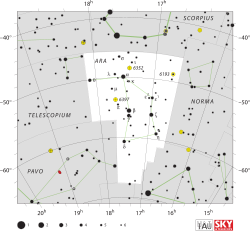Epsilon2 Arae
| Observation data Epoch J2000 Equinox J2000 | |
|---|---|
| Constellation | Ara |
| Right ascension | 17h 03m 08.754s[1] |
| Declination | −53° 14′ 12.97″[1] |
| Apparent magnitude (V) | 5.270[2] (5.44 + 8.65)[3] |
| Characteristics | |
| Spectral type | F5 V Fe+0.5[4] + DA3.2[5] |
| U−B color index | +0.015[6] |
| B−V color index | +0.498±0.005[2] |
| Astrometry | |
| Radial velocity (Rv) | +4.9[7] km/s |
| Proper motion (μ) | RA: −22.409 mas/yr[1] Dec.: −143.793 mas/yr[1] |
| Parallax (π) | 37.3696±0.1347 mas[1] |
| Distance | 87.3 ± 0.3 ly (26.76 ± 0.10 pc) |
| Absolute magnitude (MV) | 3.27[8] |
| Orbit[9] | |
| Primary | ε2 Ara Aa |
| Companion | ε2 Ara Ab |
| Period (P) | 41.3 yr |
| Semi-major axis (a) | 0.589″ |
| Eccentricity (e) | 0.622 |
| Inclination (i) | 133.8° |
| Longitude of the node (Ω) | 73.6° |
| Details | |
| ε2 Ara Aa | |
| Mass | 1.40+0.01 −0.02[10] M☉ |
| Radius | 1.8[2] R☉ |
| Luminosity | 4.56[2] L☉ |
| Surface gravity (log g) | 4.29[8] cgs |
| Temperature | 6,577[8] K |
| Metallicity [Fe/H] | +0.02[8] dex |
| Rotational velocity (v sin i) | 45.4[11] km/s |
| Age | 1.77+0.29 −0.26[10] Gyr |
| ε2 Ara C | |
| Mass | 0.65[5] M☉ |
| Temperature | 15,570[5] K |
| Other designations | |
| CPD−53°8316, GC 22956, GJ 3985, HD 153580, HIP 83431, HR 6314, SAO 244388, PPM 345633, WDS J17031-5314A[6] | |
| Database references | |
| SIMBAD | data |
Epsilon2 Arae is a double star in the southern constellation of Ara. Its name is a Bayer designation that is Latinized from ε2 Arae, and abbreviated Epsilon2 Ara or ε2 Ara. Based on parallax measurements, it is 89 light-years (27 parsecs) distant from Earth. With a combined apparent visual magnitude of 5.27,[2] this system is faintly visible to the naked eye as a point of light.
The brighter star is a magnitude 5.44 F-type main sequence star with a stellar classification of F5 V Fe+0.5.[4] The Fe+0.5 notation indicates that it has a somewhat higher than normal abundance of iron. It has an estimated age of 1.8[10] billion years and a relatively high rate of rotation with a projected rotational velocity of 45 km/s.[11] This star has 1.4[10] times the mass of the Sun and 1.8 times the Sun's radius.[2] It is radiating 4.56[2] times the luminosity of the Sun from its photosphere at an effective temperature of 6,577 K.[8] The metallicity of the star, a measure of the abundance of more massive elements, is similar to the Sun.[8] It is a candidate pulsating star.[12]
There is a magnitude 8.65 stellar companion, component Ab, at an angular separation of 0.590 arcseconds.[3] The pair have an estimated orbital period of 41.3 years.[9] A common proper motion white dwarf companion, WD 1659-53, lies at an angular separation of 113.76″. Designated component C, it is magnitude 13.47 with a classification of DA3.2.[13][5]
References
[edit]- ^ a b c d Brown, A. G. A.; et al. (Gaia collaboration) (2021). "Gaia Early Data Release 3: Summary of the contents and survey properties". Astronomy & Astrophysics. 649: A1. arXiv:2012.01533. Bibcode:2021A&A...649A...1G. doi:10.1051/0004-6361/202039657. S2CID 227254300. (Erratum: doi:10.1051/0004-6361/202039657e). Gaia EDR3 record for this source at VizieR.
- ^ a b c d e f g Schofield, Mathew; et al. (2019), "The Asteroseismic Target List for Solar-like Oscillators Observed in 2 minute Cadence with the Transiting Exoplanet Survey Satellite", The Astrophysical Journal Supplement Series, 241 (1): 12, arXiv:1901.10148, Bibcode:2019ApJS..241...12S, doi:10.3847/1538-4365/ab04f5.
- ^ a b Eggleton, P. P.; Tokovinin, A. A. (September 2008), "A catalogue of multiplicity among bright stellar systems", Monthly Notices of the Royal Astronomical Society, 389 (2): 869–879, arXiv:0806.2878, Bibcode:2008MNRAS.389..869E, doi:10.1111/j.1365-2966.2008.13596.x, S2CID 14878976.
- ^ a b Gray, R. O.; et al. (July 2006), "Contributions to the Nearby Stars (NStars) Project: Spectroscopy of Stars Earlier than M0 within 40 parsecs: The Northern Sample I", The Astronomical Journal, 132 (1): 161–170, arXiv:astro-ph/0603770, Bibcode:2006AJ....132..161G, doi:10.1086/504637, S2CID 119476992.
- ^ a b c d Holberg, J. B.; et al. (November 2013), "Where are all the Sirius-like binary systems?", Monthly Notices of the Royal Astronomical Society, 435 (3): 2077–2091, arXiv:1307.8047, Bibcode:2013MNRAS.435.2077H, doi:10.1093/mnras/stt1433.
- ^ a b "* eps02 Ara". SIMBAD. Centre de données astronomiques de Strasbourg. Retrieved 2015-03-03.
- ^ Holmberg, J.; et al. (July 2009), "The Geneva-Copenhagen survey of the solar neighbourhood. III. Improved distances, ages, and kinematics", Astronomy and Astrophysics Supplement Series, 501 (3): 941–947, arXiv:0811.3982, Bibcode:2009A&A...501..941H, doi:10.1051/0004-6361/200811191, S2CID 118577511.
- ^ a b c d e f Balachandran, Suchitra (May 1, 1990), "Lithium depletion and rotation in main-sequence stars", Astrophysical Journal, Part 1, 354: 310–332, Bibcode:1990ApJ...354..310B, doi:10.1086/168691.
- ^ a b Tokovinin, Andrei (July 2017), "Orbit Alignment in Triple Stars", The Astrophysical Journal, 844 (2): 103, arXiv:1706.00748, Bibcode:2017ApJ...844..103T, doi:10.3847/1538-4357/aa7746, ISSN 0004-637X.
- ^ a b c d Aguilera-Gómez, Claudia; et al. (June 2018), "Lithium abundance patterns of late-F stars: an in-depth analysis of the lithium desert", Astronomy & Astrophysics, 614: A55, arXiv:1803.05922, Bibcode:2018A&A...614A..55A, doi:10.1051/0004-6361/201732209, eISSN 1432-0746, ISSN 0004-6361.
- ^ a b Schröder, C.; et al. (January 2009), "Ca II HK emission in rapidly rotating stars. Evidence for an onset of the solar-type dynamo" (PDF), Astronomy and Astrophysics, 493 (3): 1099–1107, Bibcode:2009A&A...493.1099S, doi:10.1051/0004-6361:200810377.[permanent dead link]
- ^ Baade, D.; Kjeldsen, H. (July 1997), "A spectroscopic search for high azimuthal-order pulsation in broad-lined late F- and early G-stars.", Astronomy and Astrophysics, 323: 429–441, Bibcode:1997A&A...323..429B.
- ^ "GJ 2125 -- White Dwarf", SIMBAD Astronomical Database, Centre de Données astronomiques de Strasbourg, retrieved 2010-07-28.

